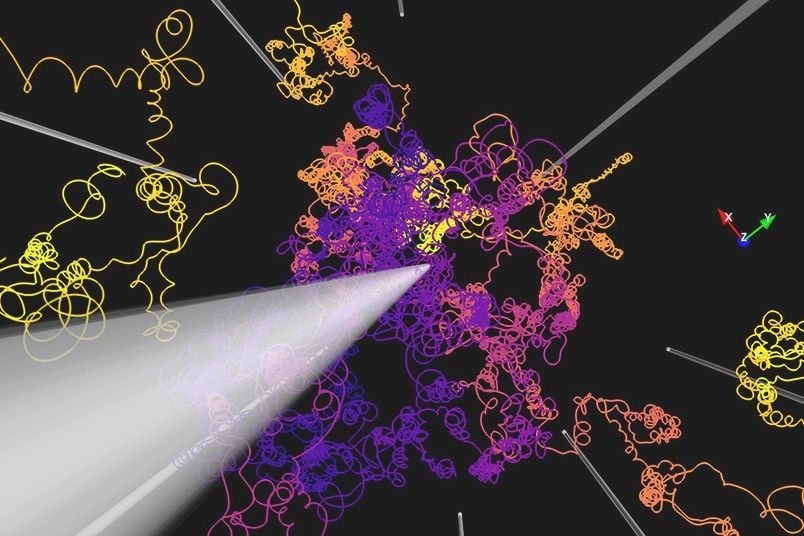A computer program created by a global research team can simulate the movement of cosmic rays through space. The goal is to help the researchers unravel the riddle surrounding the origins of cosmic rays. The source of the high-energy radiation that bombards the Earth from space is currently unknown.
 The colored lines show how cosmic rays are deflected in magnetic fields. The white straight lines represent a large-scale magnetic field. In addition, small-scale magnetic fields not shown here act on the paths of the particles (colored lines). Image Credit: RUB, Dr. Lukas Merten
The colored lines show how cosmic rays are deflected in magnetic fields. The white straight lines represent a large-scale magnetic field. In addition, small-scale magnetic fields not shown here act on the paths of the particles (colored lines). Image Credit: RUB, Dr. Lukas Merten
Theoretical models are required to understand experimental results; the new computer simulation can provide these. The software is described by a group of RUB scientists in the online edition of the Journal of Cosmology and Astroparticle Physics, which was released on September 12th, 2022.
Like an Evenly Illuminated Sky during Daytime
Cosmic rays have been studied since their discovery 100 years ago, and scientists have been trying to figure out where they come from.
The issue is that, when seen from Earth, they appear to be equally brightly illuminated—practically everywhere researchers look—as much as the sky does during the day.
This is due to the sun’s light being evenly distributed around the sky due to atmospheric scattering. Cosmic magnetic fields interact with cosmic rays to disperse them as they travel to Earth. From Earth, all researchers can see is a uniformly lighted image—the radiation’s source is unknown.
Particle Trajectories Simulated From Production to Detection
Our program CRPropa enables us to trace the trajectories of particles from their formation to their arrival on Earth – and this for all energies that we can observe from Earth. We can also fully account for the interaction of the particles with matter and photon fields in the Universe.
Julien Dörner, Ph.D. Student, Ruhr-Universität Bochum
The application can simulate the production of neutrinos and gamma rays during cosmic ray interactions and the transmission of cosmic rays.
“Unlike cosmic rays, these messenger particles can be observed directly from their sources, as they come to Earth on a straight path. We can also use the software to predict such signatures from neutrinos and gamma rays from distant galaxies such as starbursts or active galaxies,” explains Dr. Patrick Reichherzer, a postdoctoral researcher at RUB.
The simulation program that has been shown today offers the most comprehensive software and opens up new vistas of the cosmos.
“We can explore new energy ranges in the simulation that couldn’t fully be captured in such detail with the programs available to date. Most importantly, we can develop a theoretical model that describes the transition from cosmic rays from our Galaxy to a fraction coming from distant galaxies and compare it with observations,” says Professor Karl-Heinz Kampert from the University of Wuppertal.
Theoretical Calculations Essential to Interpret Experimental Data
A multinational team of 17 scientists from Germany, Spain, the Netherlands, Italy, Croatia, England, and Austria worked together to create the simulation program. The RUB is a leading collaborator in the project and has eight researchers.
The project was directed as part of the Collaborative Research Centre (CRC) 1491 “The Interplay of Cosmic Matter,” sponsored by the German Research Foundation.
The publication is a major step towards a quantitative description of the transport and interaction of cosmic rays in three dimensions. CRPropa will significantly contribute to understanding where cosmic rays come from. After all, we need theoretical calculations to help us interpret the variety of data we receive from the various instruments monitoring the cosmos.
Julia Tjus, Professor, CRC spokesperson
Journal Reference:
Batista, R. A., et al. (2022) CRPropa 3.2 — an advanced framework for high-energy particle propagation in extragalactic and galactic spaces. Journal of Cosmology and Astroparticle Physics. doi.org/10.1088/1475-7516/2022/09/035.